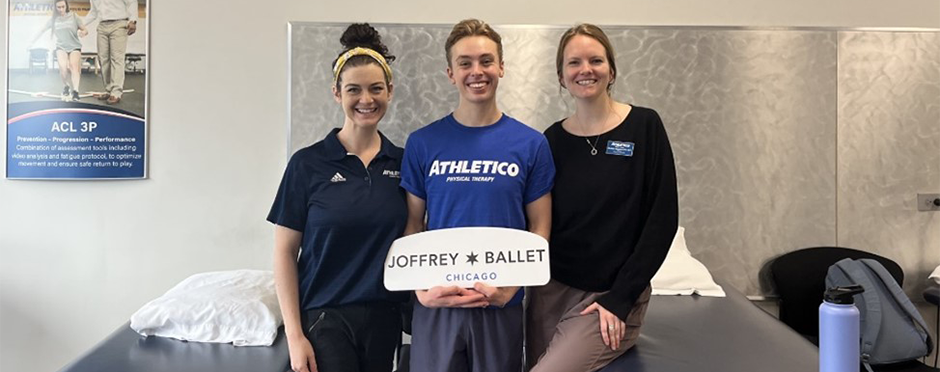
The Road to Recovery: From ACL Tear to the Joffrey Ballet
1 CommentACL injuries are often talked about in contact sports, but ballet dancers are also at risk of a tear. Jumping is the most common mechanism of injury for a ballet dancer to tear their ACL. Max Dawe, of the Joffrey Ballet, learned this firsthand last summer. I had the pleasure of being Max’s Physical Therapist in the later stages of his rehab while Alyssa Hartley, PT, DPT, OCS worked with him during the first eight months. Recovering from an ACL reconstruction is a long and intense process focused on regaining strength, range of motion, neuromuscular control, and progression of agility and plyometrics tailored to specific sport demands. The general recommended timeline to return to sport is at least nine months due to the high risk of re-injury returning at the previously thought six months. I interviewed Max asking about his recovery process, and we are happy to share his experiences.
Meet Max
Max has been a dancer with the Joffrey Ballet for three years. He danced at the Royal Ballet School in London from ages 14-19 prior to joining Joffrey’s professional company. When asked about his experience at Joffrey, Max says it has been “a learning experience. Professional life is completely different to being in school. Ballet’s focus shifts from training and learning to performing. It’s strenuous in different ways. Joffrey has an amazing, encouraging environment.” His favorite part about this company is an “amazing collection of staff and dancers who are as passionate about ballet as I am.”
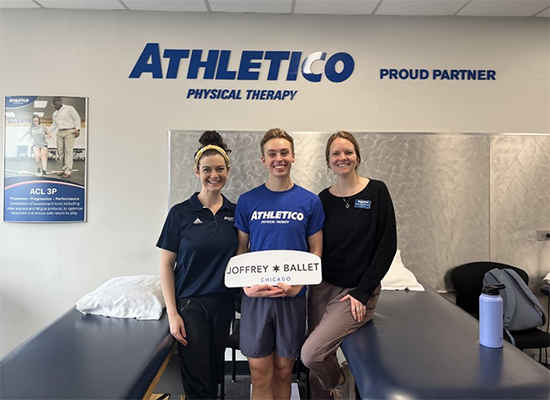
Alyssa, Max, and Maddie at Max’s last week of PT.
Max Recalls His Initial Injury
“Late August 2022 I was fortunate enough to be collaborating on a piece with another artist with the company and I lost my balance in one of the big turning jumps and fumbled my landing resulting in me misplacing my feet and twisting my knee.”
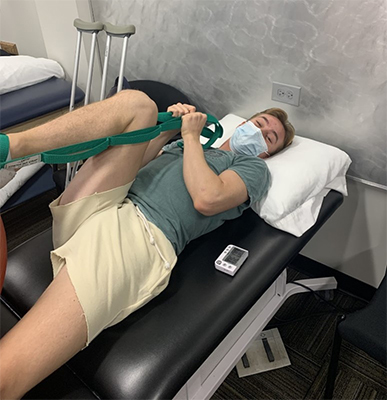
Max completing PT prior to his surgery for range of motion and strength.
Q: What was early recovery like for you?
A: “I struggled to accept the fact that I couldn’t do anything to turn back time and undo my fall. Injuries affect so much more than your physical being which was the biggest surprise.”
Q: What was your involvement at Joffrey throughout recovery? What was it like and how did you stay involved?
A: “The staff was extremely comforting when it initially happened. All I needed was people telling me that everything was going to be okay because that’s hard to see in a situation like that. I intentionally separated myself from the company at first. It’s hard to see your peers carry on as if nothing happened when your world stops, but I soon started to watch performances again. This helped with accepting that it was my goal to join them again! Sometimes I would sit in the dressing room and talk to the dancers while they were getting ready, which weirdly helped with inserting myself back into the environment.”
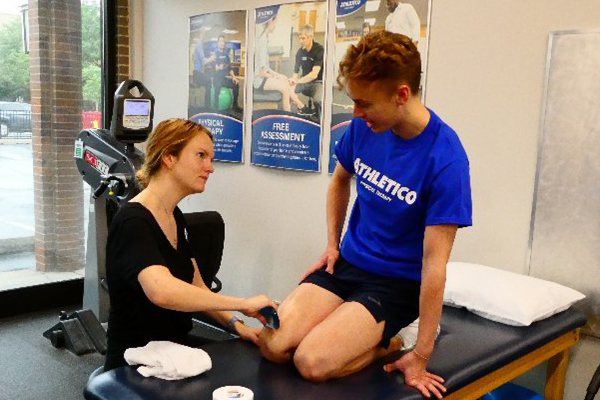
Max had manual therapy completed on his quad tendon, his graft site, to reduce pain with muscle loading.
Q: When did you first return to class and what was that like for you?
A: “I started privately working on class work before returning with the company again. I felt like it was important for me to come back slowly. Technique comes from the ground up, and I needed to make sure my basics were strong before getting carried away with everything else. I was lucky enough to work closely with one of my previous teachers and create an environment where I could make mistakes to improve.”
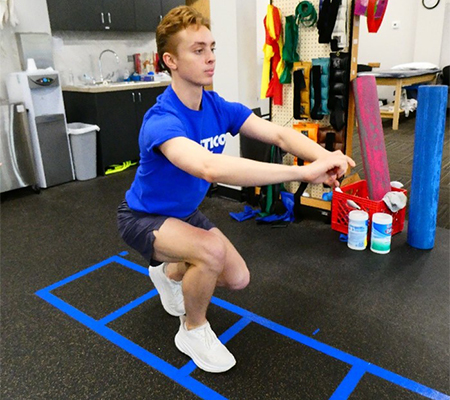
Max working on quadriceps strengthening at end range knee flexion, nine months after surgery.
Q: What was the hardest skill to get back?
A: “Everything was hard to get back. You just find repetition is the only way to reduce discomfort and fear which is draining. It requires a lot of perseverance. As I’m reaching the end of my recovery process, I find that big turning jumps such as double tours, double solabasque, etcetera are the hardest to achieve. These steps are frequently unstable for most dancers let alone with a previous injury which effects your proprioception.”
Q: What was it like during the first week back fully in class and rehearsal at the start of the new season?
A: “Tiring but fulfilling. You never expect that other variables other than ballet can be so draining. Learning to not constantly think about my knee throughout an eight-hour day. Instead, focusing on recovery between rehearsals, remembering choreography, and doing my exercises when I have the chance are some things I never expected to be so hard.”
Joffrey’s season began on July 24th, which was 10 months after Max’s surgery.
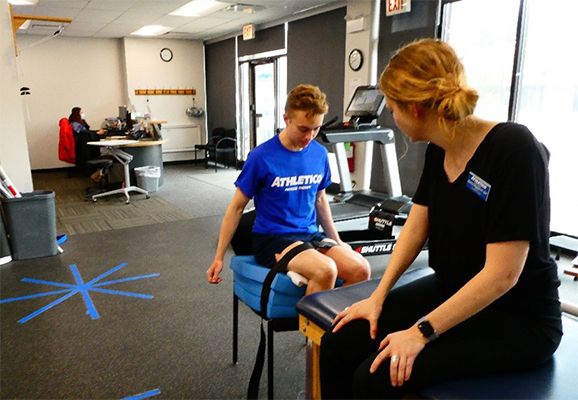
Max completing isometric strength testing to assess limb symmetry.
Q: Did anything surprise you coming back? Was anything easier than you expected or harder than you expected?
A: “Throughout my injury I was scared I wouldn’t have the same passion for ballet. When something hurts you, it’s hard to trust it again. Thankfully I was wrong! I still love everything about it and when I dance, it feels a lot different since coming back. I feel so much more passion and am grateful to do what I do!”
Q: Do you have any advice to give to a dancer who is going through the same recovery process?
A: “Keep going. A lot of the days will be tough and seem like they never end. It’s easy to lose yourself during the recovery process but focus on the positives and find happiness where you can. It will be worth the fight!”
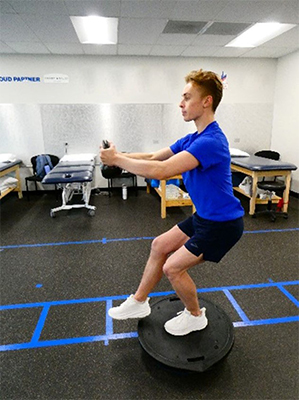
Max working on single leg stability with core and arm strengthening in preparation of partnering.
Q: What are you most excited for this season?
A: “I’m excited for Nutcracker. It’s one of the most tiring parts of a dancer’s year. With strenuous performances for the whole month of December, it can be a tough time, but I’m excited for the Christmas magic and to be part of a wonderful production.”
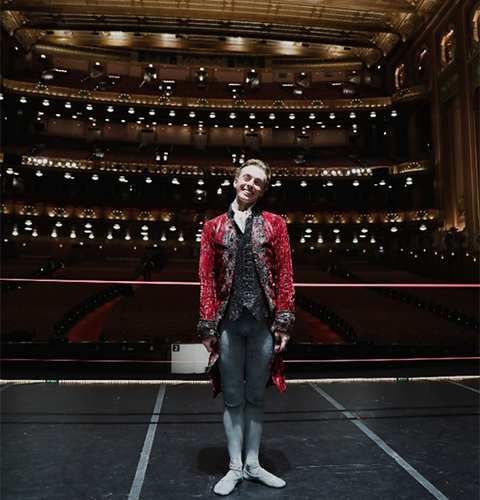
Max back at Joffrey, nine months after surgery.
You can see Max and the rest of the Joffrey Ballet in their performances throughout the year at the Lyric Opera House.
- Nutcracker: December 2nd – 27th
- Studies in Blue: February 15th – 25th
- Midsummer Night’s Dream: April 25th – May 5th
If you are a dancer looking for PT services, find a performing arts specialist near you!
The Athletico blog is an educational resource written by Athletico employees. Athletico bloggers are licensed professionals who abide by the code of ethics outlined by their respective professional associations. The content published in blog posts represents the opinion of the individual author based on their expertise and experience. The content provided in this blog is for informational purposes only, does not constitute medical advice and should not be relied on for making personal health decisions.
References:
1. Liederbach M, Dilgen FE, Rose DJ. Incidence of anterior cruciate ligament injuries among elite ballet and modern dancers: a 5-year prospective study. Am J Sports Med. 2008;36(9):1779-1788. doi:10.1177/0363546508323644
2. Beischer S, Gustavsson L, Senorski EH, et al. Young Athletes Who Return to Sport Before 9 Months After Anterior Cruciate Ligament Reconstruction Have a Rate of New Injury 7 Times That of Those Who Delay Return [published correction appears in J Orthop Sports Phys Ther. 2020 Jul;50(7):411]. J Orthop Sports Phys Ther. 2020;50(2):83-90. doi:10.2519/jospt.2020.9071

1 Comment
Lisa Gaige
Hi, This was an interesting story and Im very happy for Joff. Knee acl repairs, replacement or anything other to do with knee recovery takes a long time. I was not fortunate enough to get that much time off work which had negative impact on my life ~ 25 years later- now working on neck. Please all.. go to pt and gain all your strength before you jump back into your normal routine!
Current Clark’s Summit Pivot patient. Thank you!